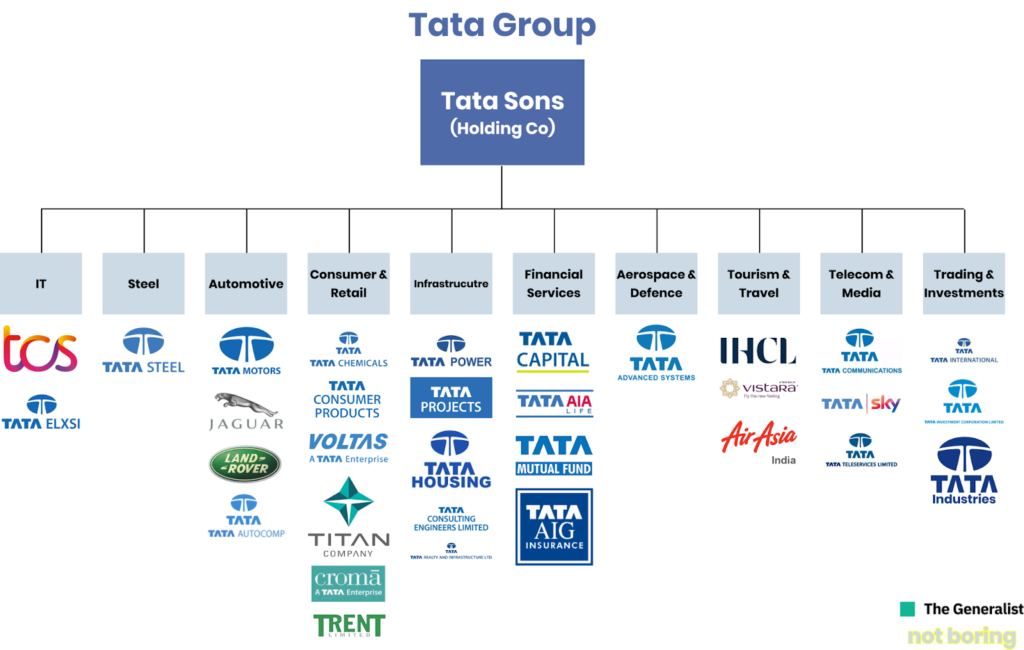The Legacy of Tata Group: How It Became India’s Most Respected Conglomerate
The Tata Group is one of India’s oldest and most respected conglomerates, with a presence in over 100 countries and a legacy spanning more than 150 years. From steel and automobiles to IT, aviation, and telecommunications, Tata has played a key role in shaping India’s industrial and economic landscape.
Unlike many business empires that focus purely on profits, Tata has always prioritized nation-building, social welfare, and ethical business practices. Today, it is a $150+ billion group, owning globally recognized brands like Tata Steel, Tata Motors, TCS, Tata Power, Tata Chemicals, and Air India.
But how did Tata’s journey begin? How did it grow into a global powerhouse while maintaining its values? This blog will take you through the story of the Tata Group, its visionary leaders, key milestones, and powerful business strategies, offering valuable lessons for entrepreneurs.
The Beginning: How Tata Group Was Founded
1. Early Life of Jamsetji Tata – The Visionary Founder
- Jamsetji Tata, the founder of the Tata Group, was born in 1839 in Navsari, Gujarat.
- Coming from a Parsi family of traders, he understood business from an early age.
- He graduated from Elphinstone College, Mumbai, and later worked with his father in the trading business.
Jamsetji believed that India needed to develop its own industries to reduce dependence on British imports. He was determined to industrialize India and laid the foundation for the Tata Group in 1868.
2. The Birth of Tata & Sons in 1868
- Jamsetji started Tata & Sons as a trading company in Mumbai with an investment of ₹21,000.
- He initially traded cotton, opium, and tea, expanding business relations with Europe and America.
- Soon, he realized that India needed its own industries—not just trade.
This led him to establish key industries that changed India’s economic landscape.
Tata’s Expansion: Key Milestones That Built an Empire
3. Tata Steel: India’s First Private Steel Plant (1907)
Jamsetji Tata dreamed of making India self-reliant in steel production, a sector dominated by British companies.
- Though he passed away in 1904, his son Dorabji Tata fulfilled his dream by establishing Tata Steel in 1907.
- It became India’s first private steel plant, producing high-quality steel for industries and infrastructure.
- During World War II, Tata Steel supplied materials for British war efforts, gaining international recognition.
4. Tata Power: India’s First Hydroelectric Plant (1910)
- Tata also believed in sustainable energy and established Tata Power in 1910.
- It built India’s first hydroelectric power plant, supplying electricity to Mumbai.
5. Tata Airlines: The Birth of India’s Aviation Industry (1932)
- In 1932, J.R.D. Tata, a pioneering aviator, launched Tata Airlines, which later became Air India.
- Air India was India’s first commercial airline, and it set international standards for Indian aviation.
- The Indian government later nationalized Air India, but Tata reacquired it in 2021, bringing it back under the Tata Group.
6. Tata Motors: Revolutionizing India’s Automobile Industry (1945)
- In 1945, Tata entered the automobile industry by producing locomotives and heavy vehicles.
- In 1991, Tata launched its first passenger car—Tata Sierra, followed by Tata Indica (1998), India’s first indigenously built car.
- Today, Tata Motors owns Jaguar Land Rover (JLR) and is a leader in electric vehicles (EVs) and commercial vehicles.
7. Tata Consultancy Services (TCS): The IT Revolution (1968)
- TCS was founded in 1968 as an IT services company.
- It pioneered India’s outsourcing industry, making India a global IT hub.
- Today, TCS is the world’s second-largest IT services firm, contributing significantly to Tata Group’s revenue.
8. Tata’s Entry into Telecommunications (2000s)
- Tata entered the telecom industry with Tata Indicom and Tata Docomo.
- Though it later exited telecom, Tata’s data center and tech businesses continue to thrive.
Business Strategies That Made Tata a Global Giant
1. Ethical Leadership and Corporate Social Responsibility (CSR)
- Tata follows a “People Over Profits” philosophy.
- Over 66% of Tata Group’s shares are held by charitable trusts, funding education, healthcare, and rural development.
- Example: Tata built the Indian Institute of Science (IISc), Mumbai’s Tata Memorial Hospital, and multiple schools and research centers.
2. Diversification & Risk-Taking
- Tata expanded into multiple industries, ensuring resilience.
- From steel and cars to IT and aviation, Tata constantly innovates.
3. Global Expansion & Acquisitions
- Tata acquired Jaguar Land Rover (2008), Tetley Tea (2000), and Corus Steel (2007), making it a global brand.
- These acquisitions helped Tata compete on the world stage.
4. Innovation & Sustainability
- Tata invests in electric vehicles (EVs), green energy, and digital technology to stay ahead.
- Tata Nexon EV is India’s best-selling electric car, leading the EV revolution.
Lessons Entrepreneurs Can Learn from Tata
✔ Think Long-Term: Tata plans for future generations, not just immediate profits.
✔ Value Ethics & Trust: Tata’s reputation is built on integrity, making it India’s most trusted brand.
✔ Diversify Smartly: Tata expanded into multiple industries, reducing risks.
✔ Invest in Innovation: TCS and Tata Motors focus on cutting-edge technology.
✔ Give Back to Society: Tata’s success is tied to nation-building and social impact.
Conclusion: The Future of Tata Group
The Tata Group continues to expand, focusing on:
✅ Electric Vehicles (EVs) & Green Energy
✅ Artificial Intelligence & Digital Services
✅ Global Expansion in IT & Retail
With a strong legacy and forward-thinking leadership, Tata will continue to be India’s most respected business group.
Also read The Role of Entrepreneurship in Wealth Building, Diversification Strategy: The Key to Minimizing Risk and Maximizing Returns, The Journey of Reliance: How It Became India’s Biggest Company
Check out Tata Group’s Official Website, More on Tata Group



